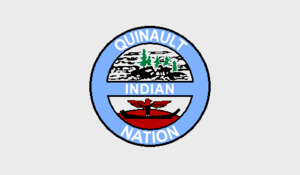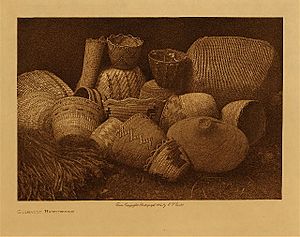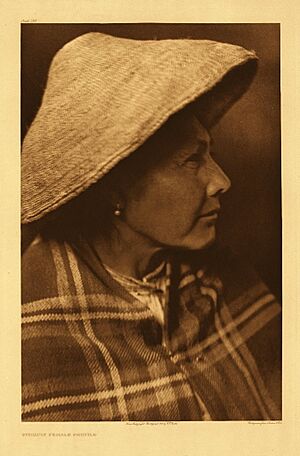Quinault people facts for kids
 |
|
| Regions with significant populations | |
|---|---|
| United States (Washington) | |
| Languages | |
| English, formerly Quinault language |
The Quinault are a group of Native American people. They live in western Washington State in the United States. They are part of the Coast Salish group and are officially recognized as the Quinault Indian Nation.
The name 'Quinault' comes from 'kʷínayɬ'. This was the name of a village at the mouth of the Quinault River. Today, this village is called Taholah. A fur trader named Charles William Barkley gave the river, village, and people the name Quinault in 1787.
Contents
Quinault Lands and Home
The Quinault Indian Reservation is on the Pacific coast of Washington. It is mostly in Grays Harbor County. A small part of it reaches into Jefferson County.
The reservation covers about 819 square kilometers (316 square miles). In 2000, about 1,370 people lived there. The Quinault people moved to these lands after signing a treaty in 1856. About 60% of the people on the reservation live in Taholah. This community is on the coast, at the mouth of the Quinault River.
If you are driving, be aware that you cannot drive through the whole reservation on Highway 109. The highway stops before reaching U.S. Highway 101 to the north. Only tribe members and private property owners can access some northern coastal areas.
Today, only members of the Quinault Indian Nation and their guests can go onto the beaches. Guests can get special passes to use the beaches for a day.
Quinault Culture and Traditions
Language of the Quinault
The Quinault people used to speak the Quinault language. Today, most Quinault people speak English.
Related Native American Groups
The modern Quinault tribe includes people from many groups. These include the Quinault, Hoh, Chehalis, Chinook, Cowlitz, Queets, and Quileute peoples. These groups speak different languages. Some speak Chimakuan, some Chinookan, and others Salishan languages.
Basket Weaving and Art

The Quinault people are well-known for their basket making and weaving skills. They made baskets from materials found nearby. These materials included reeds, grasses, spruce, maple, and red cedar. They made many different styles of baskets for different jobs. For example, baskets for gathering shellfish had an open weave. This allowed water to drain out. They were made from water-resistant materials like cedar bark.
Archaeologists have learned how basket making changed over time. The Ozette Indian Village Archeological Site is a very important place. It is about 40 miles up the coast from the Quinault reservation. A mudslide there preserved many old objects. These included baskets and blankets that would normally decay.
Quinault baskets are now in many museums. People have tried to keep traditional basket-making alive on the reservation. However, the style has mixed with that of other tribes.
Quinault Economy and Jobs
Many tribes in the Pacific Northwest give money payments to their members. However, the Quinault Indian Nation does not currently do this. The Quinault Indian Nation's economy mainly comes from a few sources. These include the Quinault Beach Resort and Casino. They also earn money from timber (wood) and fishing businesses. One example is Quinault Pride Seafood. The Quinault Indian Nation is the largest employer in Grays Harbor County. This means they provide the most jobs there.
Quinault Communities
See also
 In Spanish: Quinault para niños
In Spanish: Quinault para niños


